Fowl Cay Coral Reef Heavily Damaged After Wreck—Where Is Bakers Bay Club?
A barge and tugboat have crushed a protected coral reef—and Bakers Bay Club refuses to act. Fowl Cays bleeds while the billionaires stall and their subcontractors sue each other.
Published May 2, 2025
A vivid coral reef sanctuary is under siege in the Abaco Islands—not by a hurricane or warming seas, but by the grounded remains of a tugboat and barge left to decay in one of the Bahamas’ most ecologically sensitive and internationally important coral reef zones. More than a year after a tugboat was carrying a barge en route to the Bakers Bay Golf & Ocean Club, both rammed into the coral reef at Fowl Cays National Park, and now both vessels sit atop the reef, grinding coral into rubble and exposing systemic failures in Bahamas’ environmental laws and the lack of corporate accountability of developers in far flung destinations.
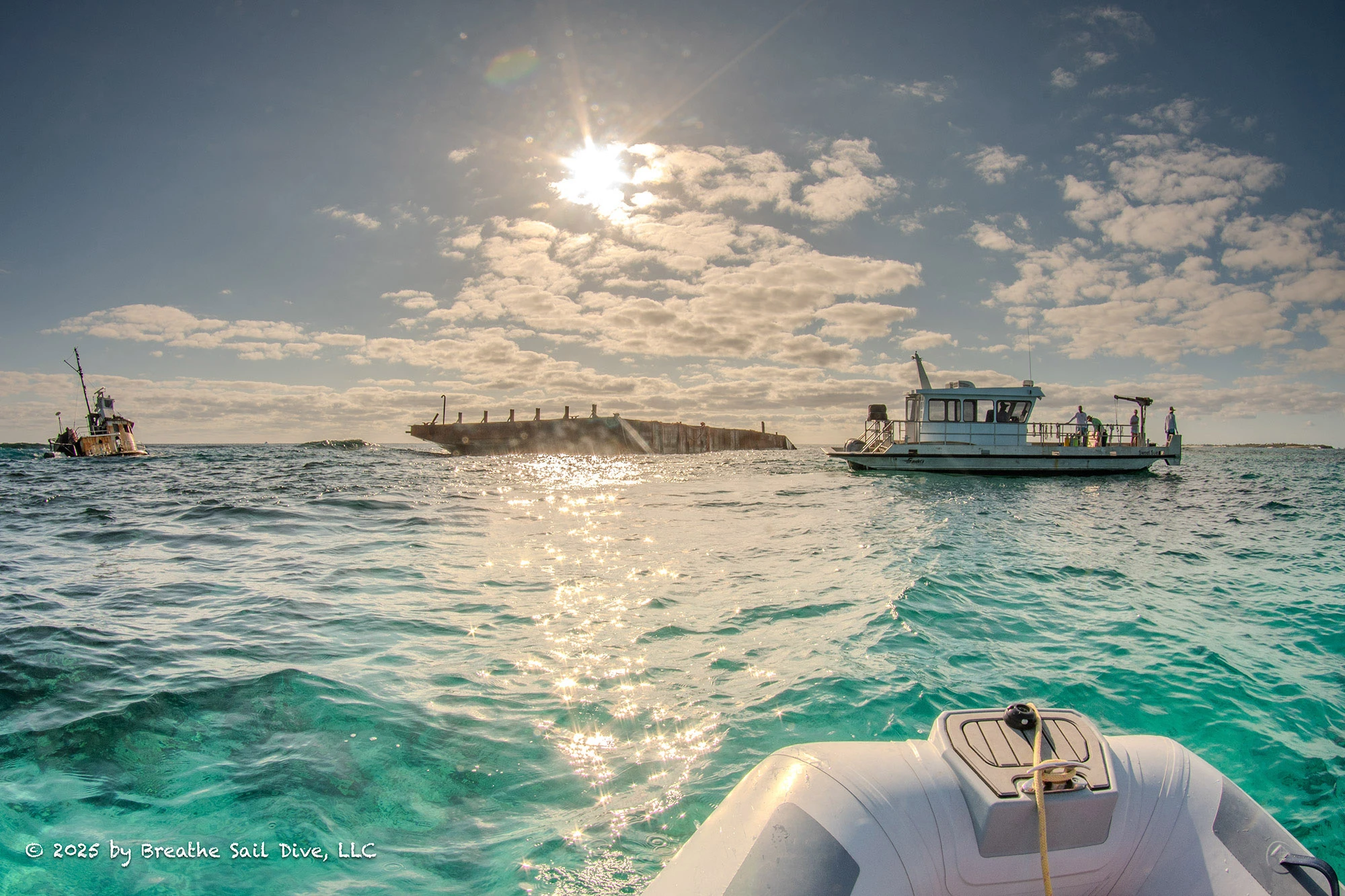
Volunteers with minimal resources reach the wreck site. Photo by Jason Spitz of Breathe Sail Dive.
The tug and barge, grounded since March 2024, were carrying construction materials for the megadevelopment at Bakers Bay on Great Guana Cay. Since the incident, endangered Elkhorn corals have been damaged, reef structures pulverized, and sandy plumes have continued to blanket coral reef and seagrass habitats; a potential death knell for long-term reef survival. Local volunteer divers and researchers have documented scenes of extensive scarring and detritus strangling what were once vibrant reef colonies, with some warning that entire reef tracts may be lost without immediate action. And volunteers led by The Perry Institute for Marine Science (PIMS), Friends of the Environment and other local groups desparately try to clean up the site with scuba tanks and blowtorches.
Despite the clear and ongoing environmental emergency, the vessels remain in place while the shipping subcontractors spar in a legal dispute.
According to an article in Eyewitness News citing Supreme Court filings, “Executive Marine Management Services was hired in March 2024 by the multi-billion-dollar Baker’s Bay development to transport sand and stones from Freeport to Great Guana Cay. The company, in turn, subcontracted the tugboat from FowlCo Maritime and Project Services to tow its barge. When the tug and barge ran aground on March 26, 2024, the Port Department formally ordered both parties to remove the wreck. Instead, their dispute spiraled into a $5 million-plus lawsuit, leaving the barge to batter the reef while the matter drags on in court.”
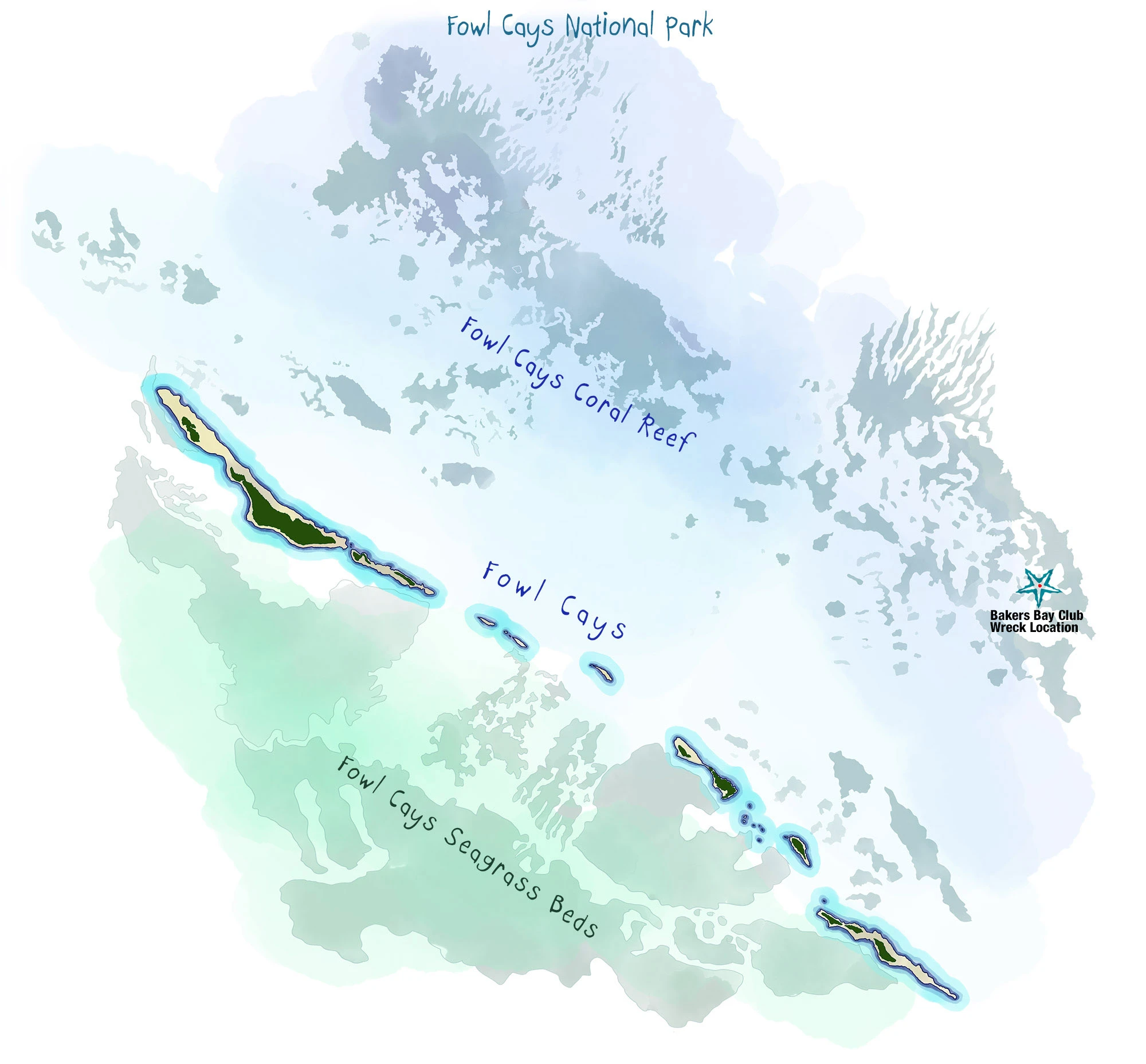
Map of Fowl Cays and Fowl Cays National Park by Erik Gauger of Notes from the Road.
Meanwhile, Bakers Bay has distanced itself from the incident, citing the conflict between third parties as a barrier to removal efforts. But conservation leaders argue that such deflection is a smokescreen. As the primary beneficiary of the cargo, and as a developer operating within and adjacent to national park waters—Bakers Bay holds a fundamental responsibility to safeguard the environment and to act swiftly in the event of harm.
Regardless of the outcome of legal proceedings, Bakers Bay bears responsibility for this ecological disaster. Even if they are not legally liable, they are still the primary reason behind this travesty. From the beginning, the community of Great Guana Cay banded together as Save Guana Cay Reef, and attempted to warn the world that a sprawling golf course and marina development of this scale was incompatible with the fragile ecosystem of the Abacos. They took Bakers Bay to court, all the way to Privy Council, which acts as the final court of appeal for Commonwealth Nations. While they lost those court battles, they began The Bahamas' first conversation about the country's lack of environmental safeguards.
And yet, Bakers Bay chose to pursue a resort that required near-daily shipments of building materials and labor alongside coral reef and seagrass bed habitats and zones of unparalleled ecological life in a reef system already strained by warming seas and pollution.
Abaco’s Barrier Reef system was never going to survive the scale of this development — the fertilizers, the nutrients leaking into the ocean, and of course even the scale of this industrial marine traffic required by such a development. That was the warning. And now, with the reef grinding under the weight of grounded vessels, that warning proved an undeniable grim reality.
While Save Guana Cay Reef was primarily concerned with the impacts that the Bakers Bay marina, golf course, and nutrient leaching would have on the long-term survival of their segment of the Abaco Barrier Reef, Fowl Cay National Park lies just a few miles south and is part of the same reef system. Today, Great Guana Cay Reef and Fowl Cay Reef are considered among the healthiest and most vibrant reefs remaining in the Caribbean.
The Caribbean Basin has lost eighty percent of its coral reefs—one of the most devastating environmental tragedies in global history. Yet, the northern barrier between the Atlantic and the Bahamas, the Abaco Barrier Reef, continues to shelter some of the last great coral habitats of the entire region. Both Bakers Bay as a physical entity and the wreck at Fowl Cay represent two of the greatest ongoing threats to this vital reef.
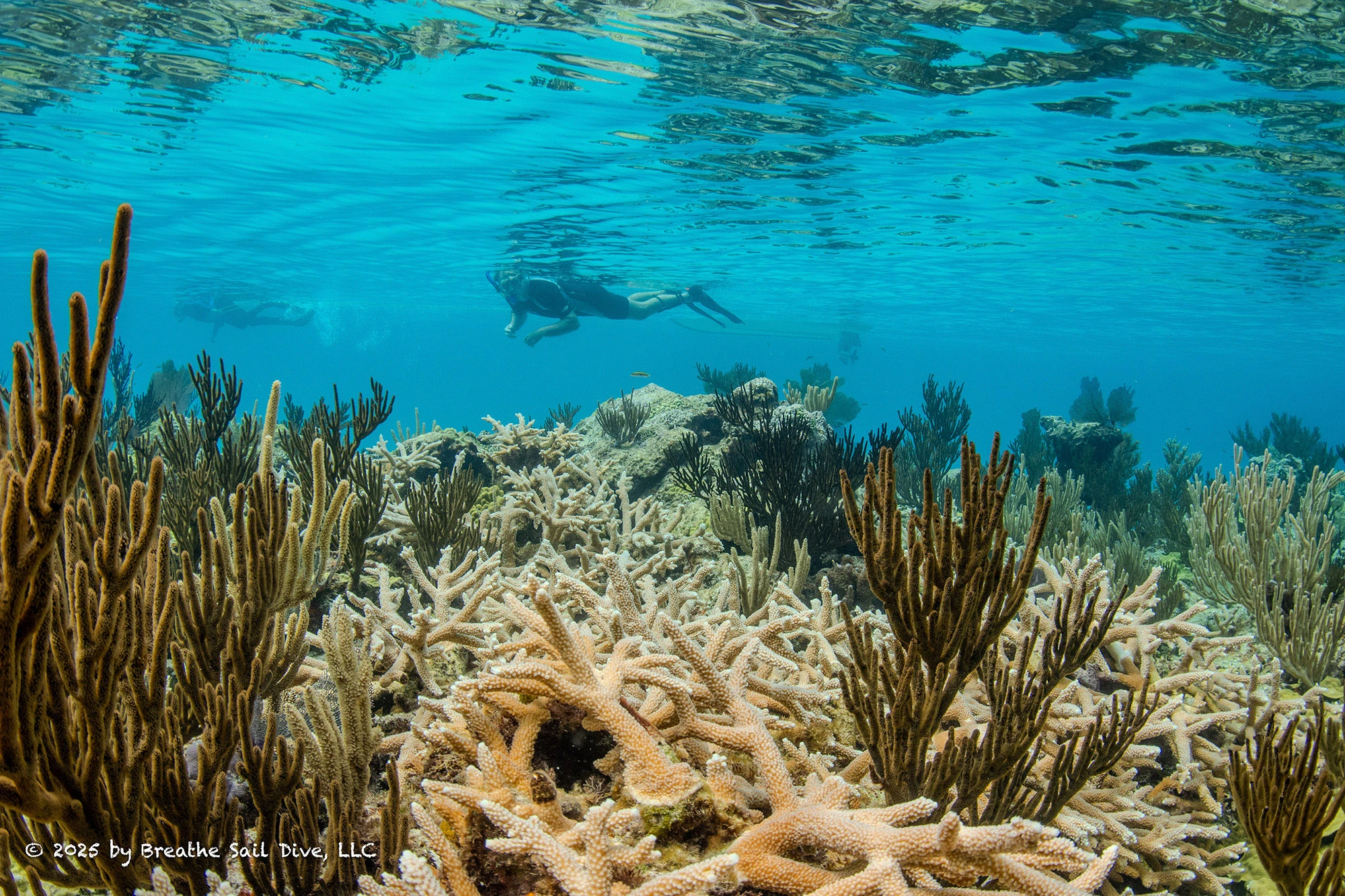
Gorgeous shallow reef at Fowl Cays National Park, not far from the wreck site, includes divers soft and hard corals. Photo from wreck site by Jason Spitz of Breathe Sail Dive.
The Ecological Importance of Fowl Cays National Park
Fowl Cays National Park is a marine and terrestrial park that includes a particularly vibrant section of the Abaco Barrier Reef. I snorkelled here many times in my youth, and remember the coral reefs, seagrass beds, outer cay forest habitat, seabird and sea turtle nesting habitat and the unique island environments of the Bahamas’ boundary with the Atlantic ocean. This reef is a haven for coral reef life. There are Green Turtles, Nassau Groupers, Queen Conchs, and dozens of coral species. The park lies at the confluence of two major Bahamian ecosystems: Atlantic Reef and Sea of Abaco seagrass flats, making it especially critical for biodiversity and the survival of many threatened species.
But the grounded barge continues to stress this fragile web. According to the Bahamas National Trust, the agency tasked with managing the country’s parks, the reef beneath the barge is suffering “progressive and cumulative damage.” With each passing day, the metal hull abrades more coral, leaving the reef less capable of recovering from storms, disease, and climate change.
As hurricane season looms, environmentalists fear that a strong storm could break the barge apart entirely, scattering debris across the park and causing even more widespread destruction.
Bakers Bay's Environmental Record
Bakers Bay has been no stranger to environmental controversy. Since its inception, the resort has repeatedly clashed with Save Guana Cay Reef and coral reef conservationists over runoff, dredging, and the sprawling scale of its development. Studies conducted by Woods Hole Oceanographic Institution have linked fertilizer runoff from the resort's golf course to harmful algae blooms and increased coral disease. Meanwhile, dredging for marina expansion destabilized the seagrass beds and disrupted nursery habitats critical for juvenile fish.
Now, the grounding of the barge proves what critics have worried about since the start.
According to the Environmental Planning and Protection Act No. 40 of 2019, The Bahamas requires developers to secure a Certificate of Environmental Clearance (CEC) before starting projects that could impact the environment. This certificate mandates adherence to approved Environmental Impact Assessments (Department of Environmental Planning and Protection, Bahamas Government). Further, Section 32 of the EPPA specifically holds developers accountable for environmental offenses committed by their employees or subcontractors, whether or not those parties are individually prosecuted (Bahamas Government, EPPA Section 32).
This robust legal framework establishes that the responsibility for environmental compliance rests squarely on the shoulders of principal developers. Yet, more than a year after the Fowl Cay grounding incident, there remains little evidence that Bakers Bay has funded or organized any substantial cleanup, raising serious questions about its adherence to these clear statutory obligations.
Yet, even if liability rests squarely with the subcontractors, we have to look more carefully at where the moral responsibility lies.
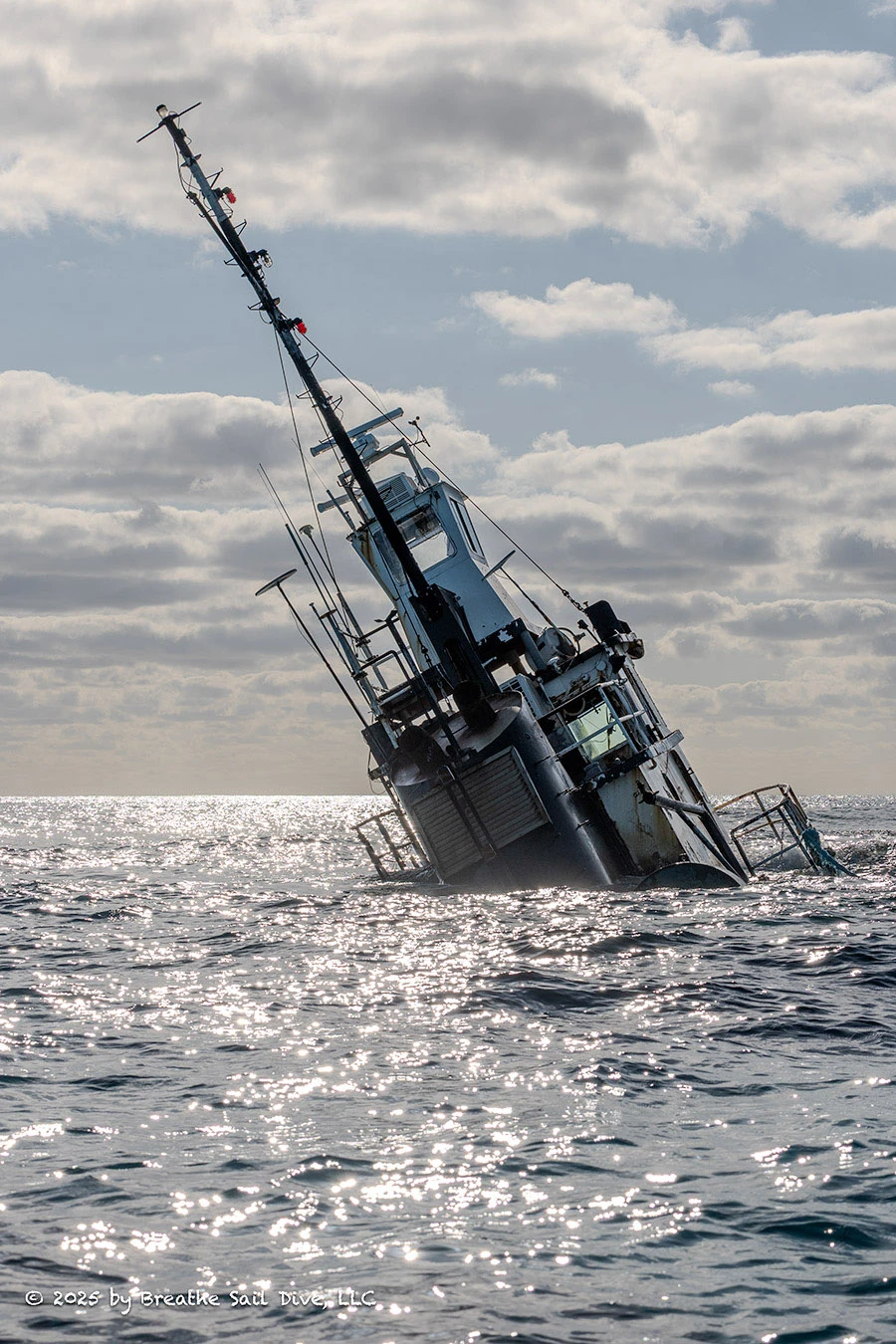
The tugboat, stuck on the Fowl Cays National Park coral reef. Photo by Jason Spitz of Breathe Sail Dive.
Grassroots Response
With Bahamian government agencies slow or completely derelict to act, it has fallen to a ramshackle group of Bahamian environmental organizations and local volunteers to stem the bleeding. Last week, a team of Bahamian environmentalists and citizen scientists organized a reef cleanup and monitoring dive at Fowl Cay, documenting the damage and removing debris where possible. Their actions, while heroic, are limited in scope and resources—and they’re no substitute for a full barge removal and formal reef rehabilitation.
“The fact that private citizens have to do this while a multi-million-dollar development watches from the sidelines is shameful.” said one volunteer.

Rope debris from the wreck is everywhere. Photo from wreck site by Jason Spitz of Breathe Sail Dive.
A Call for Accountability
As the impasse drags on, environmental groups are urging the Bahamian government to intervene decisively and some want to see Bakers Bay financially accountable for the reef damage. They point to international norms around the "polluter pays" principle, which states that entities responsible for environmental harm should bear the cost of remediation.
In 1994, when the Morris J. Berman barge collided with a coral reef near San Juan, Puerto Rico, leaching 750,000 gallons of heavy fuel oil into coral reef habitat, the U.S. government ordered the responsible parties to pay. Not only to cover clean up costs, but to compensate Puerto Rico for the natural resource damages.
Some advocates in The Bahamas are calling for stronger regulatory frameworks to prevent such incidents in the future, including tighter oversight of shipping logistics to ecologically sensitive areas and stricter penalties for inaction following environmental damage. But The Bahamas needs environmental laws with sharper teeth.
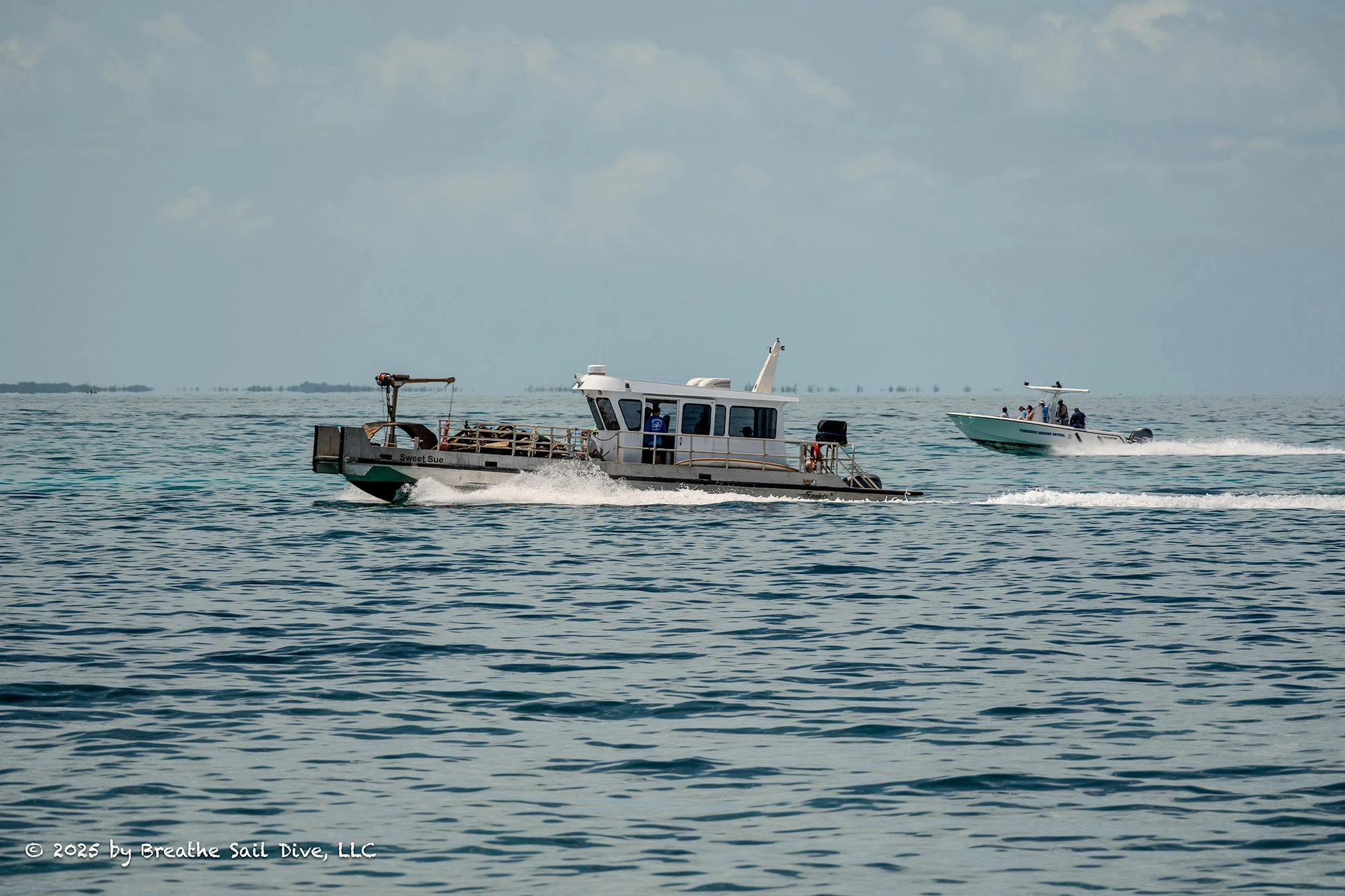
Volunteer crews, made up of locals, but absent of Bakers Bay employees or homeowners, return to Marsh Harbour to dispose of the debris and return the volunteers. The small barge is loaded with debris that was recovered from the site, an example of the daily load of debris removed by volunteers every day they work the site. Photo by Jason Spitz of Breathe Sail Dive.
High Stakes on the Fowl Cays Reef
The reef at Fowl Cays is more than a natural wonder. It’s a biological treasure trove, a foundation for Abaco Islands tourism, a safeguard against rising seas, and a nursery for species that fuel the health of the entire marine and terrestrial environment, as well as subsistence and commercial livelihoods in the Abacos.
As the barge continues to grind the reef, it also grinds away public trust in the institutions meant to protect it. For now, the coral is losing. And unless those responsible step up—regardless of who signed which subcontract—the cost will be borne not just by the reef, but by future generations of Bahamians.
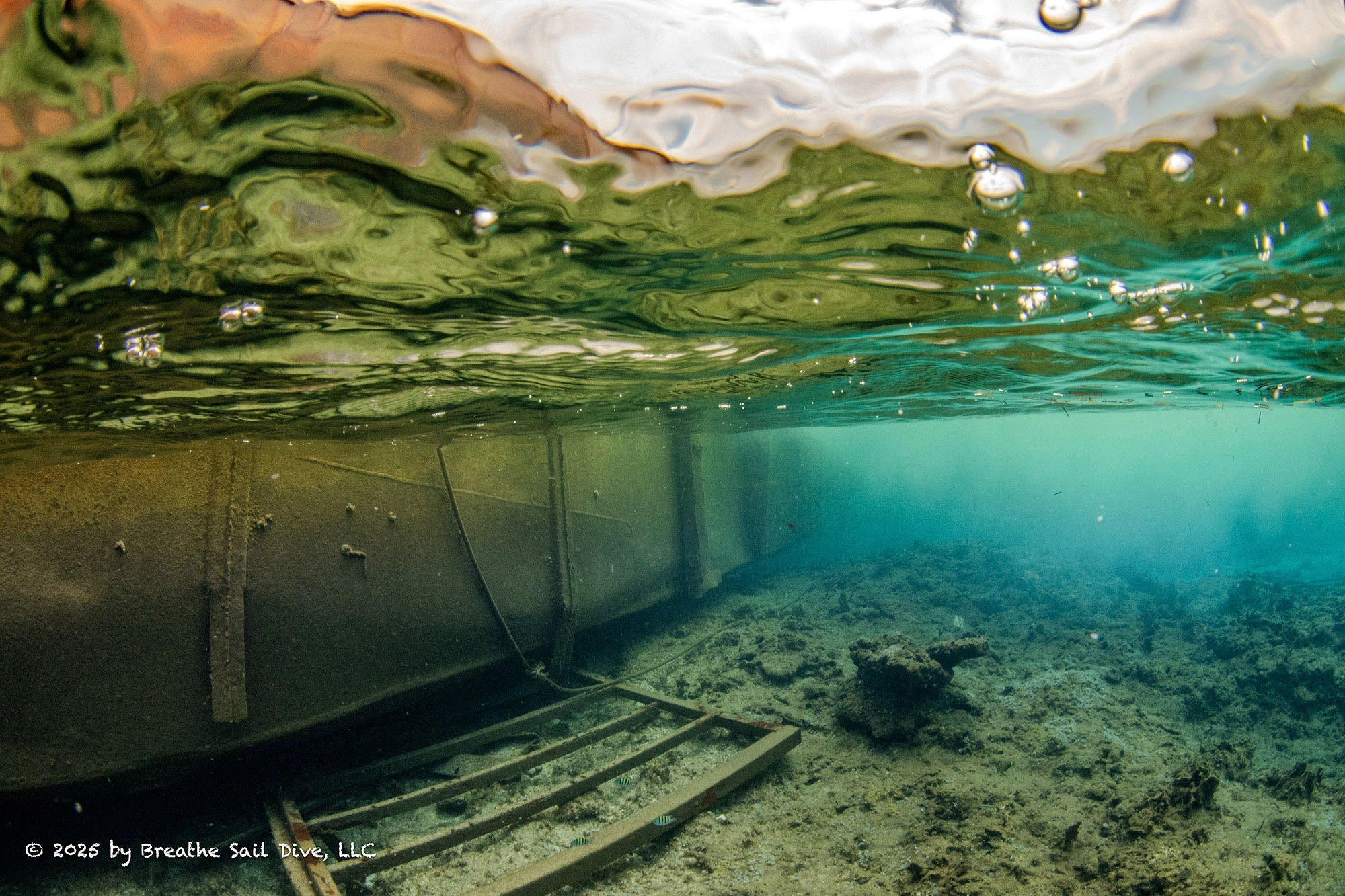
The barge scrapes up against the reef while leaching tons of sand into the coral environment. Photo from wreck site by Jason Spitz of Breathe Sail Dive.
Only One Player Can Pay the Bill
There is only one entity with both the means and the moral responsibility to remove the grounded barge and tugboat from Fowl Cays National Park: Bakers Bay Golf & Ocean Club. While legal battles over subcontractor liability play out in courtrooms and boardrooms, the reef continues to suffer. Bakers Bay has the power—and the resources—to end the damage today. Bakers Bay's parent company, Discovery Land Company, is a global developer with over $20 billion in real estate assets.
Marine salvage is expensive, but not prohibitively so for a development of this scale. Heavy-lift extractions of vessels like this dual barge and tugboat range from $2 million to $10 million, a cost which includes moving heavy lift equipment from Florida to the Abacos. In similar cases, such as the MV Wakashio disaster in Mauritius, cleanup and dismantling exceeded $10 million. More routine barge and tug extractions in U.S. waters typically fall between $1 million and $5 million.
For a luxury resort backed by billionaire investors, and billionaire celebrity homeowners, this is a rounding error, not a burden. Bakers Bay touts its sustainability initiatives and its commitment to the Bahamas—yet it continues to delay. The financial and logistical ability to fix this lies squarely with them and their parent company, Discovery Land Company. They can pursue restitution from contractors later. Right now, the only ethical and ecologically sound course of action is to get the wrecks off the reef—immediately.
Bakers Bay itself has made bold public promises about environmental responsibility. As Livingston Marshall, Senior Vice President of Environmental and Community Affairs at Bakers Bay, once said: "Baker's Bay is committed to maintaining the highest environmental performance in and around the Great Guana Cay property…"
In a press statement published in The Abaconian, the club further asserted: "Development efforts at Baker's Bay Club ensure protection of the nearby reef and marine systems. The developers...are fully aware of the importance of protecting and preserving the reef."
It's time for Bakers Bay to live up to its own words. This isn't just about money—it's about integrity, stewardship, and the future of one of the most fragile ecosystems in the Bahamas.
